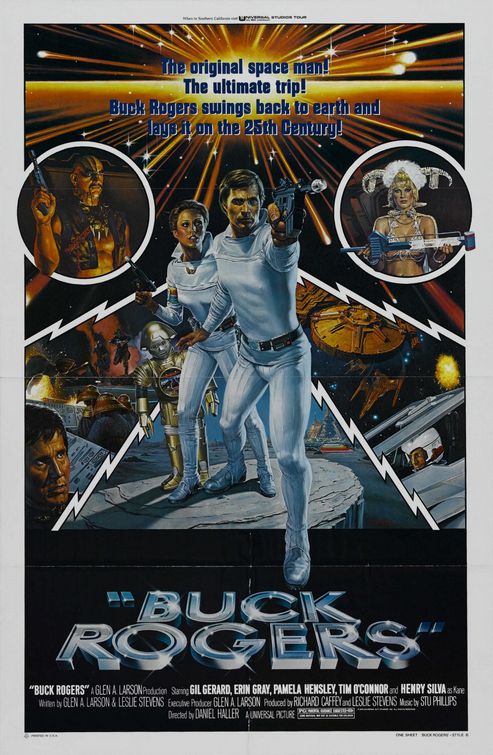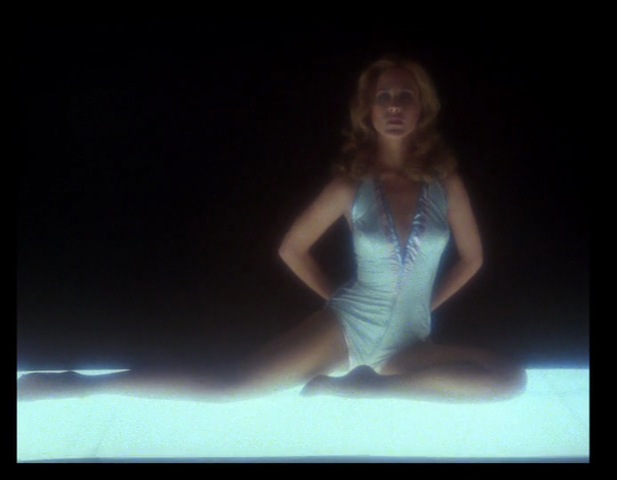B-TV: Part Six "Unsuspended Disbelief"
 Monday, August 13, 2012 at 6:00AM
Monday, August 13, 2012 at 6:00AM Buck Rogers in the 25th Century
(1979)
Synopsis
Nasa astronaut Buck Rogers’ (Gil Gerard) 1987 solo mission in space does not go as planned and through a fluke of the universe he is frozen and left to float alone in the cosmos for 500 years. Found by an alien space station on its way to a mission to Earth, Rogers is defrosted and meets Princess Ardala (Pamela Hensley) and her second in command, Kane (Henry Silva). Before Rogers even has time to comprehend what has happened to him, they put him back on his ship and send him back to Earth, hoping the bug they implanted will informed them how to break through the planet’s defenses. Back at Earth, Rogers is examined and is determined to be honest and reliable by Dr. Theopolis (Howard F. Flynn), a sentient computer carried around by a tiny humanoid robot named Twiki (Felix Silva & Mel Blanc), but that doesn’t stop military commander Colonel Wilma Deering (Erin Gray) from being suspicious of him. Declared a spy by the Earthlings once the bug on his ship is discovered, Rogers is sentenced to death but is spared after an act of heroism during a space pirate raid. Suspecting that Kane and the Princess are secretly behind the pirates, Rogers seduces and drugs Ardala and manages to sabotage their attack force, ensuring their planned invasion of Earth fails before it even has a chance to start. At last, he earns Deering’s respect, as well as a new home in a strange future.
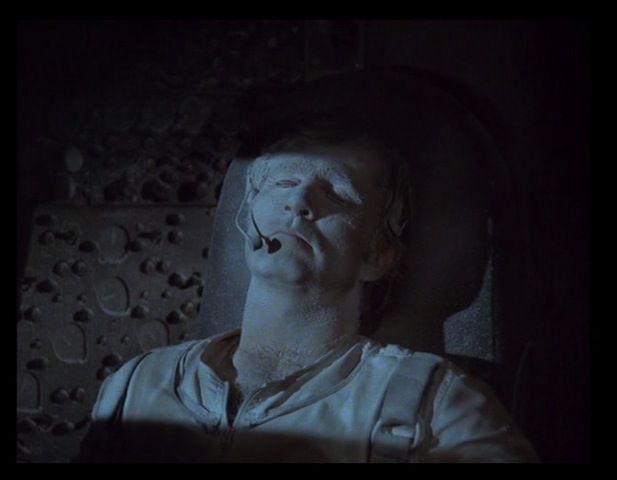
Pertinent Details
B-TV or Not B-TV: Originally conceived as the first of a series of TV movies made to capitalize on the success of Star Wars, this eventually became the pilot for a regular series instead. When the pilot of producer/co-writer Glen A. Larson’s similar sci-fi series Battlestar Galactica found success as a theatrical movie in Europe and some parts of North America, the decision was made to release Buck Rogers to theatres instead of debuting it on television as had originally been planned. There it grossed a very respectable $21 million and was later split into the first two episodes of the series that followed and would go to last for a season and a half.
Too Ballsy For Primetime: Some changes were made between the theatrical and TV versions. The theatrical version featured a memorable (see more below) opening credit sequence set to the song “Suspension” (performed by Kipp Lennon and co-written by Larson) in which Rogers lays around unconscious while Gray, Hensley and several anonymous models pose seductively, while the split TV eps used the show’s standard credits, set to an instrumental version of the song. Beyond this, scenes where Rogers calls Deering “ballsy” and Twiki refers to freezing his “ball bearings” were cut from the TV version. Several new scenes were also added to the TV version, so the resulting two episodes both came in at then-standard broadcast length. These new scenes haven’t been seen in awhile, since the released DVD set only includes the theatrical version.
An Old Established Character: Proving that 21st century executives didn’t invent the habit of going back to the past to follow and capitalize on new trends and viewer nostalgia, Buck Rogers was based on a property that was over 50 years old by the time the movie hit theatre screens. The character first appeared in a pulp fiction magazine in a story written by Phillip Francis Nowlan and subsequently became famous in other stories, a comic strip, a 1939 movie serial starring Buster Crabbe (who would go on to play a role in the first official episode of the 1979 series), and an earlier short-lived TV series that ran from 1950 to 1951.
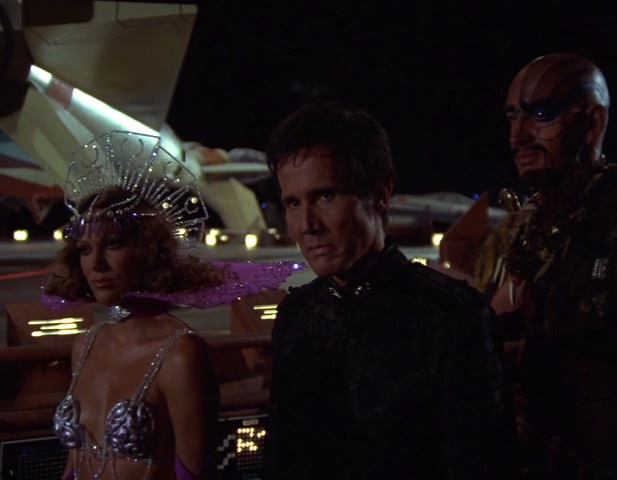
My parents are often bewildered by my ability to recall certain details of the past that they had long ago obliterated from their memories. I don’t think I necessarily possess a better grasp of my childhood than any other average person, but it probably isn’t a coincidence that many of the most powerful remembrances of my youth are tied directly to film and television. Even at the earliest possible age I found that such entertainments mattered to me more than most.
It’s because of this that the earliest memory I have that I can specifically date (as opposed to those that might have come before but are impossible for me to determine when they actually happened) occurred in the summer of 1978, when I was two years old. In it, I’m sitting/standing (I was small enough that I could comfortable do both) in the back of the Dombroski’s station wagon. It’s parked at the Twin Drive-in and I am watching a movie I would later realize was called Star Wars, which had been re-released to theatres a year after it’s original run because home video hadn’t been properly invented yet. As much as the movie impacted me later on, the film itself is secondary to my memory of the interior of that car and the salty-buttery taste of the popcorn.
That’s the earliest memory I can put a general date on. The second comes several months later, in March of 1979 to be exact. This time I’m not in a car, but a regular old-fashioned movie theatre, where I’m sitting with my parents (who may or may not have been there with the Dombroskis—who I definitely know were around in May of 1980, when I saw The Empire Strikes Back at the age of 4). Predictably, I have very little recall of the film itself. Even though I’ve always known that I saw Buck Rogers in the 25th Century in a theatre, it wasn’t until I just watched it again 33 years later that I realized the only thing I actually remembered about it was this (embedding has been disabled by the copyright owner, so click on Erin to see the whole glorious video):
So, yes, this proves without a doubt that even at three years old, all I really cared about in movies was the pretty girls, which obviously still stands today, because were it not for the presence of Pamela Hensley and Erin Gray, I would now consider the film to be a total snooze. I actually feel compelled to thank my parents (and possibly the Dombroskis) for sitting through it all those years ago, as this obviously proves that they loved me and would endure all sorts of terrible entertainment for my benefit.
Viewed with the eyes of an old, old man, the film exists in an unhappy limbo where it’s too self-conscious to descend to the cheesy heights of absurdity that transform a film like Luigi Cozzi’s Starcrash from a bold-faced rip-off to an original classic of its own, while also being too inelegantly formulaic and commercial to disguise the disinterested rote-ness of its clinical professionalism.
In other words, it’s too well made to be “so-bad-it’s-good”, which is unfortunate because it also doesn’t have the budget or imagination to transcend the innate absurdity of its concept. This isn’t a problem for television, but for a theatrical movie it’s the touch of death. (Having gotten into the series itself, I can happily report that it itself manages to satisfyingly reach the “so-bad-it’s-good” status required to redeem its existence.)
The only way most sci-fi TV shows can afford to stay on the air is to use costly action and special effects as sparingly as possible—to the point that many such shows fall under the trap Joss Whedon refers to as “radio with pictures”. It’s a trap Buck Rogers cannot avoid, partially because of a lack of resources, but also because its chief creative mind, Glen A. Larson, was a television man through and through (his other more successful efforts included Simon & Simon, Quincy, Magnum P.I., Knight Rider and—my personal favourite—The Fall Guy) and the project’s small screen origins are so inherently a part of its DNA there’s no disguising them.
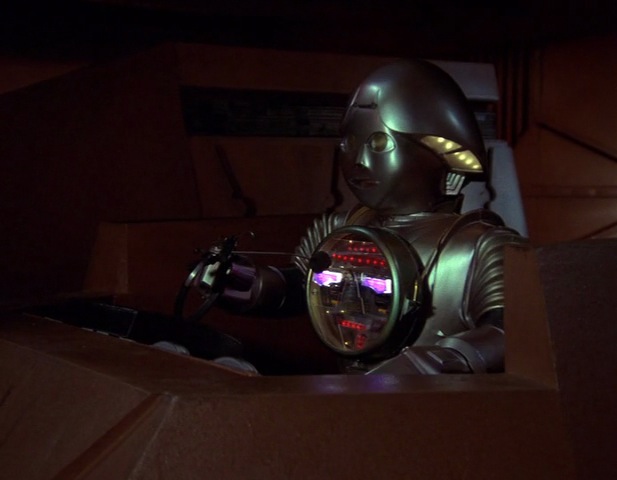
There’s no question that the movie or series would not exist were it not for the success of Star Wars, but as is typically the case, everyone involved failed to properly analyze the reasons for its success. Instead of determining that kids adored C-3PO and R2-D2 because they were a compelling comic duo who served as our gatekeepers to this strange and special universe (everything that had to be explained to them was actually being explained to us!), Larson and associates figured that kids just liked cute funny robot teams and thus gave us Twiki and Dr. Theopolis.
It’s a crucial miscalculation. Though kids were actually delighted by the comic antics of Twiki (because kids are stupid, see also Ewoks), he feels completely out of place in the context of the other characters. R2-D2 was adorable to be sure, but he not only fit in with all of the other characters, he actually managed to be as fully developed as they were—proving capable of genuine acts of heroism and generating affecting emotion. Twiki, on the other hand, is clearly just there to sell toys and make theoretically comedic comments in a voice straight out of a Loony Tunes cartoon. And Dr. Theopolis, rather than being the neurotic, tight-assed C-3PO, is just a boring clock with a face who spends all of his time telling Buck (and us) what’s going on. He’s so forgettable it wasn’t until I re-watched the movie that I remembered he existed and realized Twiki’s main purpose was to carry him around.
As Rogers Gil Gerard manages to have a few fun moments, especially those that compel him to channel his inner Han Solo, but the script both requires him to accept and deny his situation in frustratingly implausible ways, having him act more often to propel the plot than as a fully developed character.
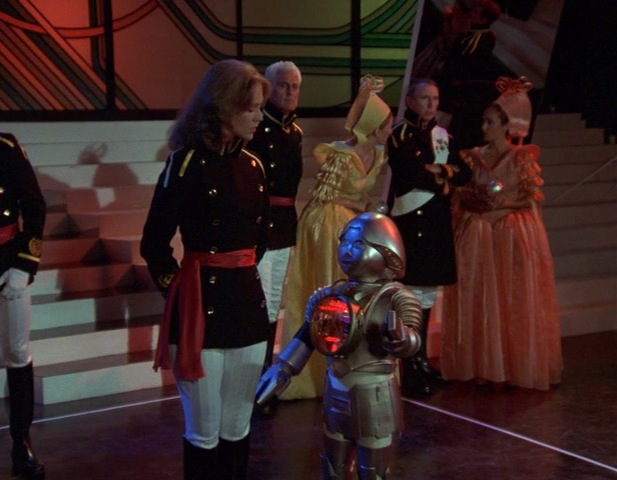
This is also true for Erin Gray, who your eyes will note was about as gorgeous as any human being was capable of being in the late 70s, but who is poorly served by a script that has her acting like an unreasonable military tight-ass in one scene and a moony-eyed dish-mop the next. The scene were she gets upset watching Buck dance with the equally-gorgeous horndog Princess Ardala is supposed to be funny, but it actually makes no sense in the context of what we’ve seen before. She’s acting that way because in television that’s how the female co-star is supposed to act when the leading man dances with the other pretty lady, not because a human being would actually act that way.
But the biggest problem is the film’s lack of urgency, which is most tellingly illustrated in the scene where Rogers, Deering and crew engage in a dogfight with what they then believe are space pirates, but are actually Princess Ardala’s men in disguise. The pirates pick off the other crewmembers with ease, leaving just our two main characters alive. No sense of weight is given to any of these deaths, and Buck even makes a joke as they turn around and fly back to Earth, apparently indifferent to the human loss. If we can’t be expected to feel anything in a moment like this, then everything else is destined to feel similarly lifeless and flat.
That said, I do love that opening credit sequence I wish I could have embedded above. It’s the closest the film ever comes to feeling at all cinematic. Had the rest of the movie shown that kind of gaudy flair I suspect I would have one more treasured childhood memory, instead of one I can just attach a specific month and a year to.
Que sera sera.
 B-TV,
B-TV,  Buck Rogers,
Buck Rogers,  Erin Gray,
Erin Gray,  Gil Gerard,
Gil Gerard,  Glen A. Larson in
Glen A. Larson in  70s action,
70s action,  B-Movies,
B-Movies,  B-TV,
B-TV,  I Saw This In The Theater,
I Saw This In The Theater,  Toys
Toys 
